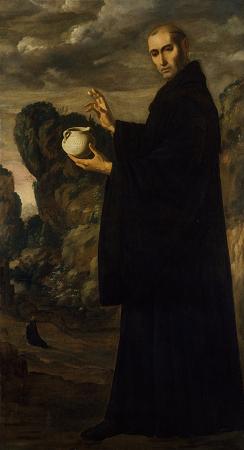Saint Benedict. Benedict of Nursia is a Christian saint venerated in the Catholic Church, the Eastern Orthodox Church, the Oriental Orthodox Churches, the Anglican Communion and Old Catholic Churches. He is a patron saint of Europe. Benedict founded twelve communities for monks at Subiaco, Lazio, Italy, before moving to Monte Cassino in the mountains of southern Italy. The Order of Saint Benedict is of later origin and, moreover, not an order as commonly understood but merely a confederation of autonomous congregations. Benedict's main achievement, his Rule of Saint Benedict, contains a set of rules for his monks to follow. Heavily influenced by the writings of John Cassian, it shows strong affinity with the Rule of the Master. But it also has a unique spirit of balance, moderation and reasonableness, and this persuaded most Christian religious communities founded throughout the Middle Ages to adopt it. As a result, his Rule became one of the most influential religious rules in Western Christendom. For this reason, Giuseppe Carletti regarded Benedict as the founder of Western Christian monasticism. Apart from a short poem attributed to Mark of Monte Cassino, the only ancient account of Benedict is found in the second volume of Pope Gregory I's four-book Dialogues, thought to have been written in 593, although the authenticity of this work has been disputed. Gregory's account of this saint's life is not, however, a biography in the modern sense of the word. It provides instead a spiritual portrait of the gentle, disciplined abbot. In a letter to Bishop Maximilian of Syracuse, Gregory states his intention for his Dialogues, saying they are a kind of floretum of the most striking miracles of Italian holy men. Gregory did not set out to write a chronological, historically anchored story of Saint Benedict, but he did base his anecdotes on direct testimony. To establish his authority, Gregory explains that his information came from what he considered the best sources: a handful of Benedict's disciples who lived with the saint and witnessed his various miracles. These followers, he says, are Constantinus, who succeeded Benedict as Abbot of Monte Cassino; Valentinianus; Simplicius; and Honoratus, who was abbot of Subiaco when St Gregory wrote his Dialogues. In Gregory's day, history was not recognised as an independent field of study; it was a branch of grammar or rhetoric, and historia was an account that summed up the findings of the learned when they wrote what was, at that time, considered 'history.' Gregory's Dialogues Book Two, then, an authentic medieval hagiography cast as a conversation between the Pope and his deacon Peter, is designed to teach spiritual lessons. He was the son of a Roman noble of Nursia, the modern Norcia, in Umbria. A tradition which Bede accepts makes him a twin with his sister Scholastica. If 480 is accepted as the year of his birth, the year of his abandonment of his studies and leaving home would be about 500. Saint Gregory's narrative makes it impossible to suppose him younger than 20 at the time. He was old enough to be in the midst of his literary studies, to understand the real meaning and worth of the dissolute and licentious lives of his companions, and to have been deeply affected by the love of a woman. He was at the beginning of life, and he had at his disposal the means to a career as a Roman noble; clearly he was not a child. Benedict was sent to Rome to study, but was disappointed by the life he found there. He does not seem to have left Rome for the purpose of becoming a hermit, but only to find some place away from the life of the great city. He took his old nurse with him as a servant and they settled down to live in Enfide. Enfide, which the tradition of Subiaco identifies with the modern Affile, is in the Simbruini mountains, about forty miles from Rome and two from Subiaco. A short distance from Enfide is the entrance to a narrow, gloomy valley, penetrating the mountains and leading directly to Subiaco. The path continues to ascend, and the side of the ravine, on which it runs, becomes steeper, until a cave is reached above which the mountain now rises almost perpendicularly; while on the right, it strikes in a rapid descent down to where, in Saint Benedict's day, 500 feet below, lay the blue waters of the lake. The cave has a large triangular-shaped opening and is about ten feet deep.On his way from Enfide, Benedict met a monk, Romanus of Subiaco, whose monastery was on the mountain above the cliff overhanging the cave. Romanus had discussed with Benedict the purpose which had brought him to Subiaco, and had given him the monk's habit.
more...




